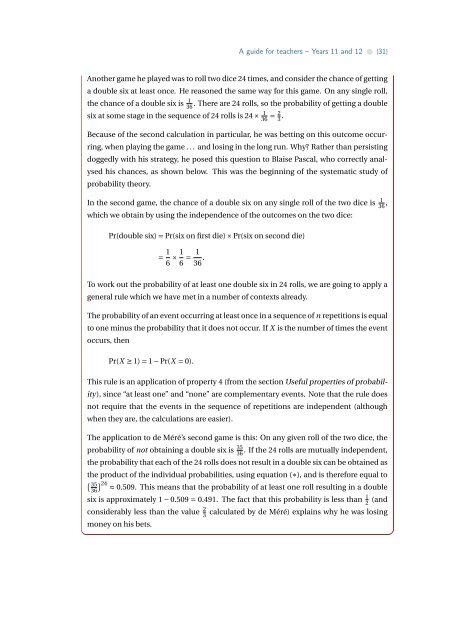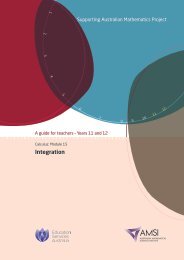Probability - the Australian Mathematical Sciences Institute
Probability - the Australian Mathematical Sciences Institute
Probability - the Australian Mathematical Sciences Institute
- No tags were found...
Create successful ePaper yourself
Turn your PDF publications into a flip-book with our unique Google optimized e-Paper software.
A guide for teachers – Years 11 and 12 • {31}Ano<strong>the</strong>r game he played was to roll two dice 24 times, and consider <strong>the</strong> chance of gettinga double six at least once. He reasoned <strong>the</strong> same way for this game. On any single roll,<strong>the</strong> chance of a double six is 136. There are 24 rolls, so <strong>the</strong> probability of getting a doublesix at some stage in <strong>the</strong> sequence of 24 rolls is 24 × 136 = 2 3 .Because of <strong>the</strong> second calculation in particular, he was betting on this outcome occurring,when playing <strong>the</strong> game . . . and losing in <strong>the</strong> long run. Why? Ra<strong>the</strong>r than persistingdoggedly with his strategy, he posed this question to Blaise Pascal, who correctly analysedhis chances, as shown below. This was <strong>the</strong> beginning of <strong>the</strong> systematic study ofprobability <strong>the</strong>ory.In <strong>the</strong> second game, <strong>the</strong> chance of a double six on any single roll of <strong>the</strong> two dice is 136 ,which we obtain by using <strong>the</strong> independence of <strong>the</strong> outcomes on <strong>the</strong> two dice:Pr(double six) = Pr(six on first die) × Pr(six on second die)= 1 6 × 1 6 = 136 .To work out <strong>the</strong> probability of at least one double six in 24 rolls, we are going to apply ageneral rule which we have met in a number of contexts already.The probability of an event occurring at least once in a sequence of n repetitions is equalto one minus <strong>the</strong> probability that it does not occur. If X is <strong>the</strong> number of times <strong>the</strong> eventoccurs, <strong>the</strong>nPr(X ≥ 1) = 1 − Pr(X = 0).This rule is an application of property 4 (from <strong>the</strong> section Useful properties of probability),since “at least one” and “none” are complementary events. Note that <strong>the</strong> rule doesnot require that <strong>the</strong> events in <strong>the</strong> sequence of repetitions are independent (althoughwhen <strong>the</strong>y are, <strong>the</strong> calculations are easier).The application to de Méré’s second game is this: On any given roll of <strong>the</strong> two dice, <strong>the</strong>probability of not obtaining a double six is 3536. If <strong>the</strong> 24 rolls are mutually independent,<strong>the</strong> probability that each of <strong>the</strong> 24 rolls does not result in a double six can be obtained as<strong>the</strong> product of <strong>the</strong> individual probabilities, using equation (∗), and is <strong>the</strong>refore equal to( 3536) 24 ≈ 0.509. This means that <strong>the</strong> probability of at least one roll resulting in a doublesix is approximately 1 − 0.509 = 0.491. The fact that this probability is less than 1 2 (andconsiderably less than <strong>the</strong> value 2 3calculated by de Méré) explains why he was losingmoney on his bets.
















